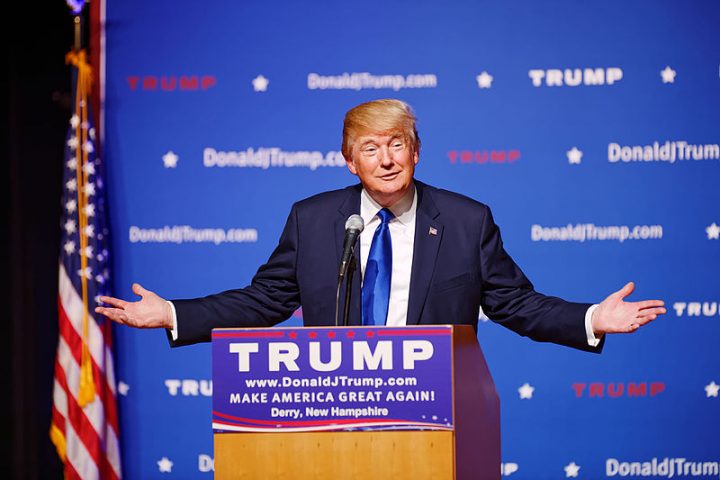“I do not feel that the media is the enemy of the people,” Ivanka Trump, the president’s daughter, asserted in a recent interview. This was the statement that noted CNN journalist Jim Acosta had tried and failed to draw from Trump spokesperson Sarah Huckabee Sanders in a White House press conference. Acosta left the room protesting Sanders’ failure to make such a statement.
Sanders did her duty as faithful spokesperson for her boss, who, a short time later, reiterated in a tweet that “fake news is the enemy of the people.” The 45th president was commenting on a meeting between A.G. Sulzberger, publisher of the New York Times, and James Bennet, the editor of the paper’s opinion section. The two journalists warned the president that “his language was not just divisive but increasingly dangerous.” They also underscored the fact that referring to the press as “enemies of the people” is “contributing to a rise in threats against journalists and will lead to violence.”
It was not the first time that Trump attacked the media as “fake news,” nor as “enemies of the people,” an expression used by leaders of authoritarian regimes to silence their opponents. The expression is not new. The same words can be found in Shakespeare’s Coriolanus. In the modern era, dictators from both left and right, Stalin and Mao, as well as Nazi propagandists, have used the words to denigrate and destroy their political enemies, even leading to assassinations and purges.
Trump attacks the media as “fake news,” raising the volume with the phrase “enemy of the people,” echoing the rhetoric of modern authoritarian nations. It’s important to remember that Trump has always had words of approval not only for Vladimir Putin, but for other dictators as well, including Kim Jong-un. In Kim’s case, the 45th president has expressed admiration for the fact that the Korean leader assumed power over his country when he was only 28 years old, ignoring the evil of the dictator’s actions.
In contrast to previous American presidents, who spoke of democracy and democratic values not just for Americans, but as a model for the rest of the world, Trump has been silent on this theme. His behavior toward journalists was atrocious during the electoral campaign, and it has only grown worse throughout his nearly two years in office. Trump does not hesitate to single out for abuse disfavored journalists like Acosta, whose question he refused to respond to at a recent press conference in London with Theresa May. Identifying Acosta as part of CNN, which he calls “fake news,” he skipped over the reporter, and then took a question from John Robert of Fox News — which many people consider the actual fake news.
When the president of a democracy like the United States verbally attacks a reporter in public, it encourages leaders of authoritarian regimes to mistreat their own press. In many of those countries, such bullying can end up with reporters in prison, or worse. Trump’s authoritarian behavior legitimizes similar actions by leaders in parts of the world unprotected by America’s first amendment and guarantee of freedom of the press.
In effect, Trump’s actions demonstrate contempt not only for journalists, but the American Constitution. The Constitution’s protection of freedom of the press, however, does not completely protect journalists in America. Acosta, for example, requires bodyguards in order to do his job covering the many Trump rallies, where it is not unusual for the 45th president to vilify the media. Trump has never told his supporters to physically attack journalists, but some of the “deplorables” could easily interpret his ferocious words as encouragement to do so. In fact, several journalists have been threatened by people declaring themselves Trump supporters.
In a recent article, New York Times columnist Bret Stephens wrote about threats he received from some of these people last May. Four weeks later, five journalists were murdered at the Capital Gazette in Annapolis, Maryland. There does not appear to have been any political motive, but obviously Trump’s incendiary characterization of the media as “enemies of the people” could lead to a similar tragedy.
Trump’s attack on the media is not always aimed at an individual. It is part of a larger effort to dismantle the truth, which is his real enemy. His attacks endeavor to create an alternative reality — a reality that comes straight out of his mouth. In fact, at a recent rally, Trump advised his devotees not to believe anything they saw written or reported by the media.
Neither the loss of faith in the media, nor the inevitable unwillingness of the media to work with Trump, is a problem for the president, because nowadays it is possible to bypass the press, communicating directly with the electorate. Trump has more than 50 million followers on Twitter — half as many as Barack Obama, but he makes very good use of them. His messages on Twitter, and at his rallies, frequently include false information and hoaxes. According to the Washington Post, the frequency of Trump’s lies and misleading claims has recently increased to 16 per day. In the 600 days of his presidency, Trump has lied 4300 times. Between his Twitter account and his frequent rallies, he is, in fact, the most prolific propagandist of fake news.
When the 45th president attacks the fake news media, he should look in the mirror.
Translated from italian by Linda Maceri






